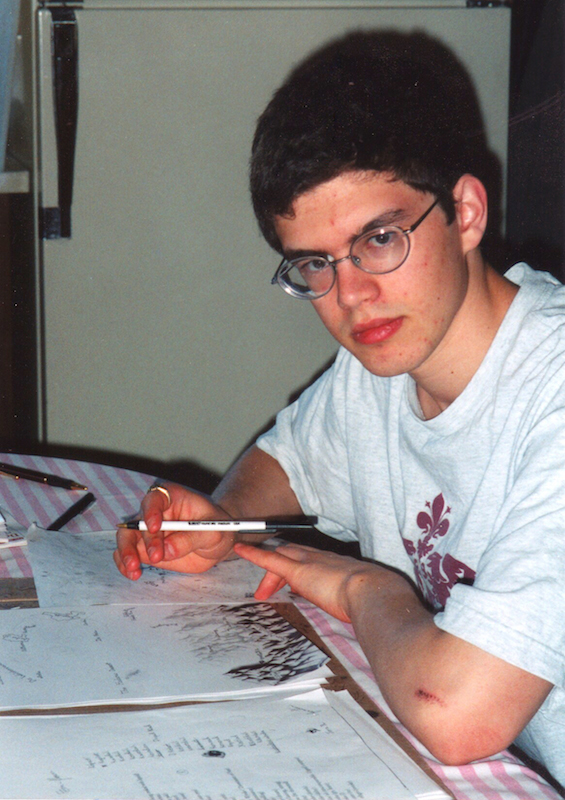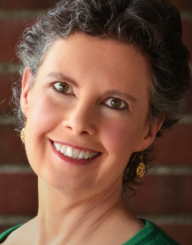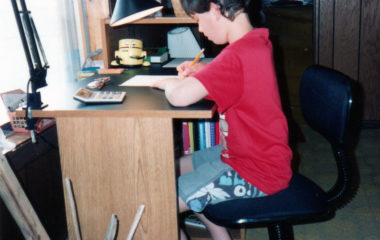I remember my son, Christopher, sitting on the floor with his math workbook, gazing out the window. Time and again I would endeavor to bring his focus back to his work, only to realize that he was again adrift amid the clouds. It was only later that I realized what he was thinking about . . . dragons!
After graduating from high school at fifteen, he decided to write a story. Not just a three to ten-page short story. Oh no! My son was determined to write a full-blown epic fantasy novel . . . and he did.

Keeping with our philosophy of supporting the interests of our children, my husband, Kenneth, and I gave Christopher the freedom to pursue his passion. In his vivid imagination, he was riding a mighty blue dragon and sharing adventures with her. Lacking funds to turn his adventure into a movie—for that is how he saw it—he wrote it. Ultimately, what he outlined became the four-book Inheritance Cycle, and it changed our lives forever.
Christopher has often said that Eragon, the first book in the Inheritance Cycle, would not exist if he had not been homeschooled. My husband and I always made books an important part of our lives, so we naturally began reading to Christopher and his sister, Angela, when they were infants. We showed them how to carefully hold a book and turn the pages slowly, so they wouldn’t tear. We cuddled our children on our laps while we read to them. Reading was a pleasurable time when they felt loved, secure, and supremely happy.
When Christopher was a toddler, we played little games with him, to introduce the sounds of the letters and associate them with pictures of objects that started with each letter’s sound, for example a for apple, b for bottle, c for cat and coat. Christopher matched pictures of these objects with letters, saying their names and sounds together. I provided craft activities that emphasized letters. One day, for example, I showed him how to trace his fingers over a giant letter “S” that I wrote on a sheet of construction paper. Together we said the sss sound. He then drizzled glue over the letter and sprinkled it with cornmeal. When it was dry, his masterpiece was hung in the kitchen where it could be admired for a time. Each day as I cooked and we chatted, I would comment on his work and ask him to tell me about it. “That’s s,” he would proudly say.
It wasn’t long before he was pointing out letters in magazines and books, and on cereal boxes and signs around town. Next, I taught him to blend the letters. We were playing a blending game with the letter c when Christopher suddenly stopped. He got a faraway look in his eyes, and then he repeated the letter sounds for the word c-a-t. He looked at me with a twinkle in his eye and a smile that grew wider and wider. “Cat,” he said, “CAT!” He leaped up and ran to get a picture of a cat. He could read.
The following years were filled with the trials and joys faced by most homeschoolers. Kenneth and I chose to continue our children’s education at home, so cooking, housekeeping, and teaching became my daily routine. We continued to read to our children daily, and encouraged them to read on their own. I taught them how to organize their work—whether it was a collection of math problems, spelling words, artwork, or writing—into little books. Each book got a construction paper cover and was stapled or bound with yarn at the sides. And I organized study units so that subjects were done in “little bites” or pages that could be collected into a book when the project was completed. Looking back over a year’s work was then a matter of perusing a neat stack of personalized mini-books—instead of a pile of loose papers.
Another factor I contribute to Christopher’s love of reading and writing is our weekly outings to the library. I can still see my son struggling to navigate down the front steps of the library with a stack of books nearly over his head, his sister similarly laden at his side. Christopher read a wide variety of subject matter, working his way through the children’s area to the young adult section to the adult stacks.
When it was time for high school, we decided to enroll both children in a distance learning program through American School, because of its accreditation and acceptance by colleges, and because we wanted them to get a firm foundation of basic subjects. Looking back, I see that we could have taught them successfully ourselves, but at the time, it was the best choice. It worked beautifully for Christopher and Angela.
Focusing several hours a day on study left Christopher time for projects of his own. He developed an interest in drawing and painting, which he later used to draw the maps and cover for his book. He designed a house: an architect friend drew up blueprints of it for him. Christopher’s love of working with his hands expressed itself as he designed and built an easel for his painting, dug an enormous hole through river rock to make himself a subterranean shelter, built a forge in our backyard, and carved beautiful wooden walking staffs and letter openers. He even learned to form and hone his own steel knives.
Each of these tasks took hours, days, weeks, and sometimes months of patient, determined, persistent work. No one told him to do them. He faced numerous challenges that he surmounted through sheer ingenuity and creativity. He learned that hard work was required to bring his visions to reality, and he gained an I-can-do-it attitude that would be needed for his greatest project of all . . . writing a novel.
Christopher didn’t realize it at the time, but many factors influenced his writing adventure. First, he had the confidence instilled by homeschooling. Never had he experienced the devastation of being told he couldn’t do something or was a failure. Second, he had the research skills and resources to find information to create his imaginary world. He delved into Nordic and Icelandic traditional epics to find the words for his “ancient language.” With renewed interest he read the Beowulf saga and found similarities between it and Tolkien’s Hobbit and Lord of the Rings. He pondered the threads that wove through these stories and more contemporary ones such as Star Wars. And he searched for his own expression of the archetypal heroic young-man-coming-of-age adventure story. Thus was born Eragon.
It took Christopher a year to write his tale. He immersed himself in several texts on “how to construct and write a story.” During that time he learned to type, his spelling improved tremendously, and he learned how to capture his mental images on paper. The challenge was that he was learning to write professionally while working on a novel-length manuscript.
Seeing the flaws in his first draft and frustrated by the way it read, he decided to rework his manuscript. His second draft took him another year. Every day he would rise, eat breakfast, and then work diligently at his computer until lunch. He tackled each paragraph with zeal, trying to convey the drama that played out in his mind. More writing, exercise, dinner, and perhaps a movie completed his day.
To help with his learning process, we provided a steady stream of reading material and movies, so he could see how other writers had created characters, written dialog, and developed plot. We analyzed different styles of writing and grammar usage. Both children delighted in dissecting novels, finding inconsistencies, and sharing what they considered horrid or great passages. During this time, Angela began writing a novel of her own.
After supporting our son’s project for nearly two years—allowing his creative process to unfold unhindered—Kenneth and I finally read Christopher’s manuscript. We loved the story and were amazed that our son had created such a captivating, expansive work. But it still needed editing. Christopher quickly discovered that, like most beginning writers, he had many repeated phrases and grammar constructions. He learned to cut words, phrases, and sometimes whole sections that didn’t support the story. With a dictionary, thesaurus, and several word usage and grammar books at hand, the final editing process became a full-time family project to make sure every word and comma was just right.
After a final review from Kenneth’s mother, an English professor of Comparative Literature, and nods of approval from several authors, we were ready to publish. We helped Christopher prepare brochures, press releases, and other promotional materials, and advised him on marketing strategies. He spoke on radio and television shows, and spent long hours hand-selling Eragon in bookstores, at fairs, and in grocery stores. He visited schools and libraries to encourage young people to read and write. In short, he promoted his book wherever possible.
It wasn’t long before readers’ enthusiastic response came to the attention of the folks at Knopf, a division of Random House. In 2003 they published Eragon and promoted the book widely. The subsequent years were a whirlwind of activity. Christopher divided his time between solitary stretches of writing Eldest, Brisingr, and Inheritance and traveling the world on book tour. His books sold millions of copies and topped best seller lists, he was interviewed on national television, and his booksignings packed halls. A Hollywood movie was made from Eragon, and he even earned a place in the Guiness Book of World Records for the youngest author of a best-selling book series. Yet amid all this, home and family were his anchor, so he retained his innate good nature—doing the dishes, as usual, when home; treating each fan with respect; and feeling gratitude for the good fortune that had come his way.
Looking back, Christopher says, “Painting, reading, carving wood, metalwork, being outdoors, and writing poems and short stories were activities I enjoyed as a child. But I never intended to become an author. The creation of Eragon was just a wild challenge for myself, my attempt to write a book that I would enjoy, and the first part of a larger story. Publication was the furthest thing from my mind. I certainly didn’t know how big a project I had tackled, but as I poured my heart and soul into the story, writing it soon overshadowed other activities. Only after the completion of Eragon did I seriously contemplate a career as a writer.”
My husband and I had no idea that by giving Christopher the opportunity to focus on his project it would someday would grow into such a large enterprise. But in hindsight we see that homeschooling allowed Christopher to reach for big goals and not feel that they were impossible; to keep a positive attitude, even when surrounded by obstacles; to have the time to think and create; and to unleash the dragons in his dreams . . . and share them with you.
Finding one’s place in the world is never easy.
Have courage and be true to who you are.
Remember, those who dare to be different are
Often the ones who change the world.~ Christopher Paolini



